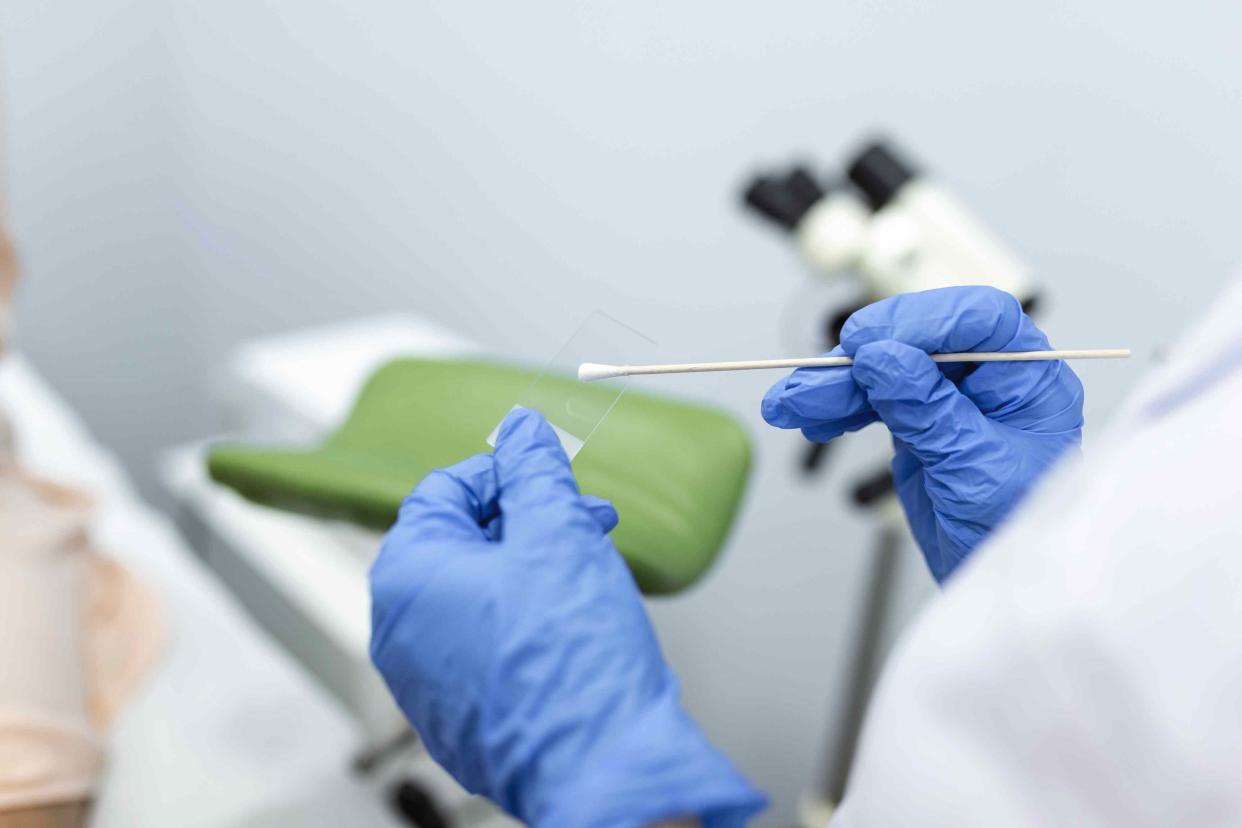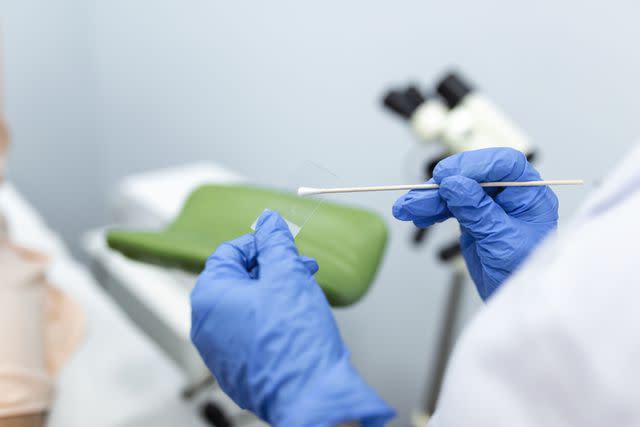What Is HPV?

stefanamer / Getty Images
Human papillomavirus (HPV) is a group of viruses commonly spread through sexual contact. It is the most common sexually transmitted infection (STI) in the United States, affecting 42.5 million Americans annually. According to the Centers for Disease Control and Prevention (CDC), most sexually active people will get HPV at some point, and about 13 million new HPV infections occur yearly.
There are over 150 strains of HPV, and the types that cause genital warts (painless lumps or growths around your vagina, penis, or anus) differ from those that can cause cancer. Many low-risk strains resolve on their own. High-risk HPV strains can cause certain cancers. But having HPV does not necessarily mean you will get cancer.
This article will review HPV signs and symptoms, transmission, risks, screening, vaccine, prevention, treatment, sex safety, and complications.

stefanamer / Getty Images
A sexually transmitted infection (STI) is when a pathogen (bacterium or virus) enters the body through sexual activity. An STI may progress into a sexually transmitted disease (STD). Many people use these terms interchangeably.
Signs and Symptoms of HPV
Most people with low-risk HPV do not have symptoms, and 90% of low-risk cases resolve independently within a few years. But, some low-risk strains (types 6 and 11) can cause genital warts.
Warts appear as bumps, growths, or lumps on or near the following:
Some "high-risk" strains lead to certain cancers. Symptoms rarely occur in the early stages of these cancers, but they can appear in later stages. Signs of these cancers are listed below in the complications section.
Related:What Genital Warts Look Like and Where They Appear
How Is HPV Transmitted?
The most common mode of genital HPV transmission is vaginal or anal sex. However, it can spread through skin-to-skin sexual contact and oral sex.
Transmission can occur anytime your genitals or mouth touch your intimate partner's genitals, mouth, or anal area. It does not require sexual intercourse or penetration. This is true even if there is no contact with a wart.
Related:9 Things You Should Know About Human Papillomavirus (HPV)
Who Is at Risk for HPV?
The following groups are at higher risk of getting HPV:
Those who are sexually active with a new partner
Those with multiple sex partners
Those who have sex with someone who has or had multiple partners
Those with a weakened immune system, including those with human immunodeficiency virus (HIV)
How to Know If You Have HPV: Testing and Preventive Screening
For people assigned female at birth, HPV testing can be done along with a Pap smear (cervical cancer screening test).
Routine cervical cancer and HPV screening recommendations for those assigned female at birth, based on age, are as follows:
21 to 29 years: A Pap smear every three years
30 to 65: A Pap smear every three years or HPV testing every five years, or a co-test (a combined Pap smear and HPV test) every five years
There is no penile HPV test available for those assigned male at birth. However, some healthcare providers perform an HPV test on an anal Pap smear for individuals who engage in receptive anal sex.
HPV Vaccine
The number of HPV cases has been decreasing since the introduction of the HPV vaccine. According to the CDC, full vaccination can prevent over 90% of cancers caused by HPV.
Gardasil-9 is the only HPV vaccine in the United States. It protects against two low-risk HPV types (6 and 11) and seven high-risk types (16, 18, 31, 33, 45, 52, and 58). Gardasil-9 does not treat existing HPV infections, but it does protect you from getting different strains in the future.
Who Should Get the HPV Vaccine?
The CDC recommends HPV vaccination for children aged 11 and 12 (before they are sexually active). However, it can be given as young as 9 years old.
They also recommend a "catch-up" vaccination for those between 13 and 26. Regardless of age, people with a compromised immune system should receive the vaccination.
If you are between the ages of 26 and 45, the CDC recommends shared clinical decision-making with a healthcare provider. Regardless of age, talk to a healthcare provider about the vaccine if you believe you are at high risk for cervical or anal cancer.
Most of the time, insurance covers the cost of the HPV vaccine. Otherwise, the price ranges between $10 and $270 per shot. There are programs available for those who have financial barriers or no insurance.
HPV Vaccination Schedule
The HPV vaccine is given in either two or three shots and varies by age.
The CDC recommends two doses for those who get their first dose before turning 15. Studies show that two doses between the ages of 9 and 14 provide as good or better protection as a three-dose schedule starting after age age 15.
Those who get the first dose after they turn 15 need three doses for full protection. The CDC also recommends three doses for those between 9 and 14 years old with a compromised immune system.
The schedule for the two- and three-dose series is as follows:
Two Doses | Three Doses |
First dose: Between the ages of 9 and 14 | First dose: Age 15 or older |
Second dose: Six to 12 months after the first dose | Second dose: One to two months after the first shot |
Not applicable | Third dose: Six months after the first shot |
Can You Prevent HPV?
There are several preventive measures you can take to decrease your risk of getting HPV, including:
Vaccination: The HPV vaccine is safe and highly effective against strains you have not yet been exposed to.
Limiting sexual partners: Limit sexual partners or remain in a monogamous relationship (only having sex with someone who only has sex with you).
Using barrier devices: Use condoms, finger cots, and dental dams correctly whenever you have sexual contact.
Treatment for HPV
When HPV causes genital warts or cervical cancer, there is treatment, but no cure.
Genital Wart Treatment
Genital warts can remain and not cause significant health risks, but some people wish to remove them for cosmetic reasons. In this case, treatment involves:
Cryotherapy: A healthcare provider uses liquid nitrogen to remove warts, with treatment usually every two weeks.
Cautery: A healthcare provider uses electricity to burn away the wart.
Surgery: A healthcare provider removes the wart using a local anesthetic (a numbing agent), scalpel, scissors, and a curette.
Topical (on the skin) creams: This includes Aldara (imiquimod), Veregen (sinecatechins), and Condylox (podofilox).
Trichloroacetic acid: This is a topical solution a healthcare provider applies weekly.
Cervical Cancer Treatment
Early detection of cervical cancer through Pap smears improves the treatment outcome and prognosis.
Surgery is the most common treatment. However, treatment options depend on staging and the type of cervical cancer and include the following:
Cone biopsy: A cone biopsy is a diagnostic test and a treatment that removes the cone-shaped part of the cervix. Techniques include cold knife conization (CKC) or a loop electrosurgical excision (LEEP).
Trachelectomy: Surgical removal of the cervix. It may also involve removing part of the vagina and lymph nodes.
Hysterectomy: During this procedure, a surgeon removes some or all of a female's reproductive organs, including the cervix.
Lymph node dissection (removal): Cancer cells can travel through the lymph fluid. Dissection is the removal and testing of the lymph nodes.
Radiation therapy: This technique uses high-energy radiation waves (similar to an X-ray) to kill cancer cells.
Systemic therapy: Medications such as chemotherapy and targeted immunotherapy can be tried.
Related:How to Prevent Cervical Cancer
Is It Safe to Have Sex With HPV?
Having sex with HPV can be risky, and you should not have sex if you have active lesions. However, having an HPV diagnosis does not mean you should avoid sex altogether.
Barrier devices like condoms or dental dams can help reduce the risk of transmitting HPV. They offer the most protection when used correctly every time. If you use a condom too late or if it slips or breaks, it provides less protection. HPV can be transmitted from other genital areas, even with condom use.
Before engaging in sexual activity with your partner, it’s best to discuss testing, vaccinations, safe sex practices, and other sexual partners. This may feel awkward, but it’s essential for your well-being. If you or your partner has HPV, remember it is very common.
Many people carry it for years without knowing it. Educate yourself about the specific strain and risks. If you need help talking to your partner, ask your healthcare provider about discussing it during an appointment together.
Related:4 Questions to Ask a New Partner Before Having Sex
Complications of HPV
Genital warts and certain cancers are complications of some strains of HPV. The strains that cause genital warts (low-risk) differ from those that cause cancers (high-risk).
There are 14 high-risk HPV strains, but the two main high-risk types are 16 and 18. These two strains are responsible for most HPV-related cancers, including the following percentages probably caused by any HPV type:
Cervical: HPV causes 91% of cervical cancer. Late symptoms include abnormal vaginal bleeding or discharge and pelvic pain.
Vulvar (rare): HPV causes 69% of vulvar (clitoris, vaginal lips, and opening to the vagina or birth canal) cancer. The most common symptom is vulvar itching.
Vaginal (rare): HPV causes 75% of vaginal (birth canal) cancers. Symptoms include painful sex, bleeding after sex, abnormal discharge, a lump in the vagina, painful urination, constipation, and pelvic pain.
Penis: HPV causes 63% of penile cancers. Symptoms include white, scaly patches, redness, blisters, or irritation on the penis.
Anal: HPV causes 91% of anal cancer. The anus is the last part of the digestive tract where poop comes out. The most common symptoms include stomach problems, rectal bleeding, anal pain, or an anal mass.
Oropharyngeal: HPV causes 70% of oropharyngeal (throat, tongue, or tonsils) cancer. The most common sign is a lump in the throat, making it hard to swallow.
The following are estimates regarding HPV-related cancers in the United States:
About 21,700 females experience cancers from HPV yearly.
About 15,600 males experience cancers from HPV yearly.
Outlook
Screening for HPV is essential for people assigned female at birth, even if you've had the HPV vaccine. If you have HPV, discuss the strain and risks with your healthcare provider. For low-risk strains, there is a good chance that your body can clear the infection within a couple of years. If HPV causes genital warts, there are effective treatments but no cure.
If you have a high-risk strain of HPV, talk with your provider about screening and testing for genital cancers. While some genital cancers (including cervical) can be fatal, early detection and treatment provide better outcomes.

